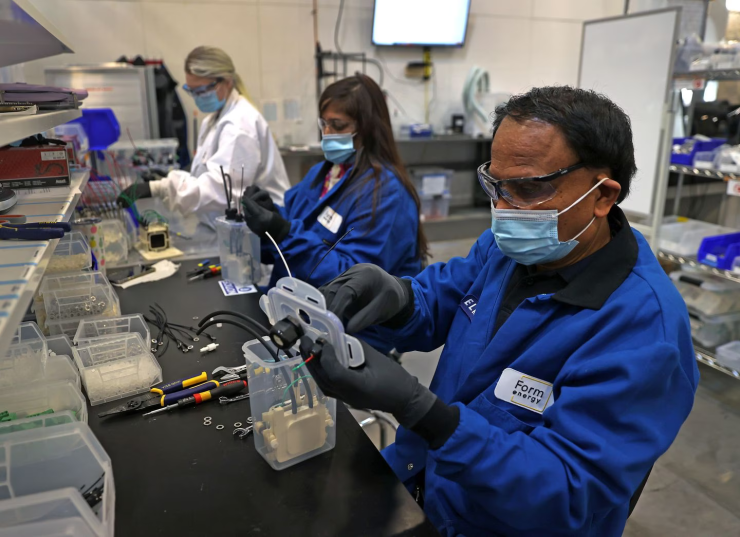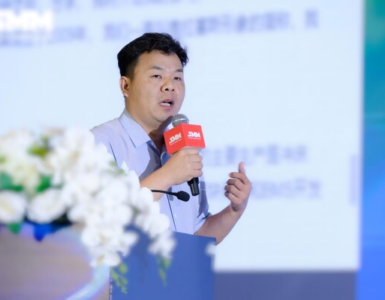Boston tech startups bet big on batteries.
[Boston Globe] A cluster of well-funded startups in Greater Boston is getting ready to change the world’s energy-storage systems. Their efforts are wide-ranging and could potentially impact everything from electric vehicles to the electric grid.In Woburn, SES AI Corp. and Factorial Energy are planning major upgrades to the lithium-based batteries found in today’s electric cars. They’re building power cells that promise longer range and lighter weight while reducing the risk of battery fires.
Meanwhile, Marlborough-based Ambri and Form Energy of Somerville are working on the more radical idea of grid storage — massive banks of batteries that can soak up excess power from solar cells or wind farms, then use it to power a whole townful of homes and businesses, for hours or even days.
Behind these companies are key technological advances in chemistry and materials, many of them pioneered at the Massachusetts Institute of Technology. These breakthroughs have put battery startups at the forefront of the region’s climate-tech sector. But the companies still have a long way to go.
Michael Aziz, professor of materials and energy technologies at Harvard University, said:
Boston’s a great place for this because there’s all this intellectual horsepower.
“It’s a good ecosystem for thinking about stuff like this.”
Indeed, the Boston area has a long history of battery innovation and a deep pool of talent. For decades, battery maker Duracell based its research labs in Needham, until parent company Procter & Gamble closed the facility in 2009. SES, Form Energy, and Ambri are all based on MIT research.
Another MIT spinoff, A123 Systems, at one time employed as many as 300 people in Waltham developing electric car batteries, before filing for bankruptcy in 2012.
A decade later, local battery companies are again money magnets, with venture investors and automobile companies pouring in hundreds of millions of dollars. Ten-year-old SES went public in February in a merger with Ivanhoe Capital Acquisition Corp., a blank-check company traded on the New York Stock Exchange.
The deal included $450 million in new investment led by automotive giants like General Motors, Honda, Kia, Hyundai, and Chinese carmaker Geely.
While today’s lithium-ion batteries contain an electrode made of lithium mixed with some other material like cobalt or nickel, SES is building lithium-metal batteries, with an electrode made of pure lithium.
This delivers about twice the energy density of today’s batteries, meaning twice as much stored energy per kilogram of weight. So an electric car that travels 250 miles on a lithium-ion battery could,in theory, cover 500 miles using a lithium-metal battery of the same size.
Or the carmaker could use a lighter battery, add more cargo space, and still increase driving range because the car would weigh less.
But there’s a catch. Since the 1970s, scientists have tried to develop lithium-metal batteries that wouldn’t break down after just a few recharging cycles. SES chief executive Qichao Hu said his 150-person company finally figured it out.
And just in time for the world’s major carmakers, who’ve committed to replacing their internal combustion engines with battery-powered electric motors.
Qichao Hu, said:
They really need a very safe and high-energy-density battery.
Hu said, “and that’s what we can offer.”
Meanwhile, Factorial Energy, which emerged from stealth mode in 2021, raised $200 million in January, in a financing round led by Mercedes-Benz and Stellantis, the Netherlands-based auto conglomerate that includes the Chrysler and Jeep brands.
Factorial’s 100 employees are focused on upgrading the lithium battery’s electrolyte — the substance that lets electrons flow between the electrodes to generate electricity. Today’s lithium-ion batteries use a liquid electrolyte, but Factorial batteries use a polymer material similar to plastic.
The company says its solid-state battery has up to 50 percent higher energy density than standard lithium batteries.
A solid electrolyte could also solve lithium batteries’ dangeroushabit of bursting into flames.
While the liquid electrolyte in a standard lithium battery has a flash point of about 140 degrees Fahrenheit, the Factorial battery’s solid electrolyte can be heated to nearly 400 degrees with no danger of fire, the company said.
And while Factorial batteries could make sense for all sorts of mobile devices, chief executive Siyu Huang says the real sweet spot is the automotive market. “This is where our passion is,” Huang said. “We really wanted to build a product that changed the landscape of clean-tech transportation.”
Beyond electric-vehicle batteries, local companies are developing large-scale systems that could someday power thousands of homes.
Form Energy has raised $370 million from investors, including a $240 million round last August led by steelmaking giant ArcelorMittal. The company is also backed by The Engine, MIT’s venture fund, and Microsoft cofounder Bill Gates’s Breakthrough Energy fund.
Gates is also the biggest single investor in Ambri, which has raised over $200 million, including a $144 million round also announced last August.
Both companies are trying to ensure that excess power from renewable sources doesn’t go to waste. A solar plant, for example, may generate too much power by day, but none at night. It’s a classic problem that’s held back solar adoption.
Adam Briggs, Ambri’s chief commercial officer, said:
You can’t guarantee that you can deliver electricity at a certain level, at a certain time of the day.
Ambri’s solution is a large bank of batteries that captures excess electricity, then releases it as needed. Based on technology developed in the lab of MIT materials scientist Donald Sadoway, Ambri uses batteries made of calcium and the metal antimony.
They’re safe, stable chemicals that won’t catch fire and cost less than the lithium and other minerals found in lithium-ion batteries. And while lithium batteries lose their ability to hold a charge after a few years, Ambri’s battery is designed with a 20-year lifespan, even if it’s fully discharged and recharged every day.
Ambri will soon begin testing its system at a major data center and said itwill roll out its first batterysystem for electric utilities in 2023.
While Ambri’s batteries are designed to provide no more than 24 hours of continuous power, Form Energy is building batteries that could keep a city’s lights blazing for several days. And the company plans to do it with two of the most common materials on earth — air and iron.
Since the 1960s, scientists have tried to invent a practical battery based on iron, which generates an electric current as it rusts. Such a battery would have high energy density and could be recharged by reversing the current flow and “de-rusting” the iron. It would be cheap to manufacture, use nonflammable materials, and last for decades.
On the downside, iron-air batteries are much heavier than lithium batteries, and they release their energy over a long period, so they won’t deliver the quick acceleration you need in an electric car.
Research on iron-based batteries languished for years.
Ted Wiley, Form Energy president:
There was no market for a battery that’s very cheap, and charges and discharges over a hundred hours.
But that has changed, as iron-air batteries could make an excellent backup power supply for an electrical grid that increasingly relies on solar and wind power.
An array of these batteries taking up the same space as a typical coal-fired power plant could store enough energy to supply 300,000 homes for about 100 hours, Wiley said. With that much power in reserve, there’d be no need to fall back on fossil-fuel plants at night, or when there’s no wind.
“A 100-percent renewable grid becomes not only possible but economic,” Wiley said.
To that end, Form Energy is building a pilot plant in cooperation withGreat River Energy of Minnesota. The 40,000-square-foot battery array, designed to power up to 400 homes for 100 hours, is set to be activated late next year.
All told, Boston’s battery startups have raised over a billion dollars from venture funds and corporate giants, just in time to support the global quest for cleaner power.
“I’ve been in batteries since 1984,” said Ambri executive Briggs, a 17-year Duracell veteran.
“This is the best time ever for batteries.”
READ the latest Batteries News shaping the battery market
Boston tech startups bet big on batteries, March 17, 2022









